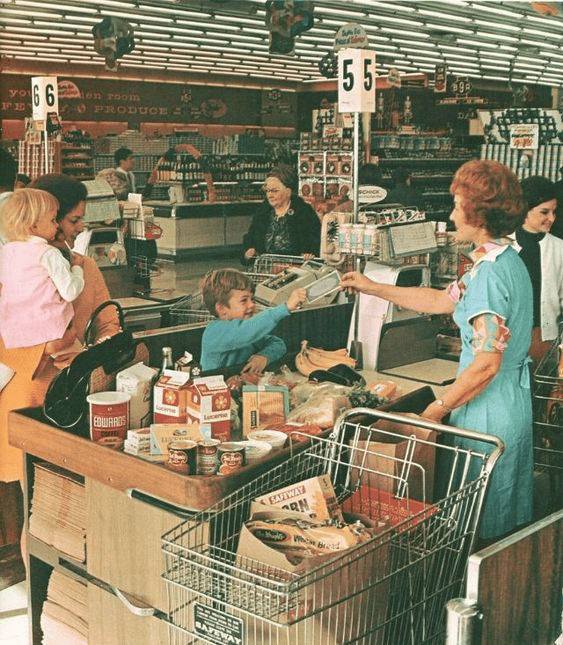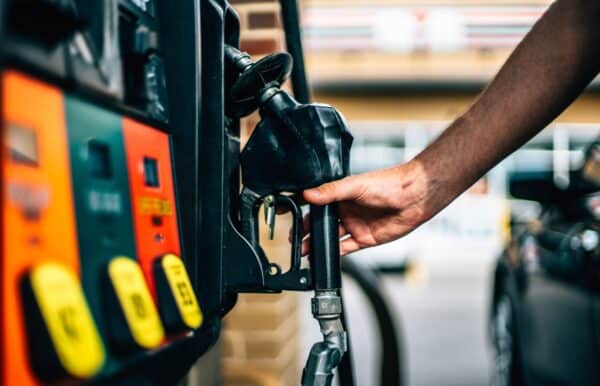Ah, the “good old days,” when a gallon of gas cost just a few dimes and the streets were lined with shiny, chrome-laden cars.
We often hear tales of the 1950s in the United States, a golden era of middle-class prosperity and seemingly boundless affordability.
But as someone navigating the economic landscape of recent years, I can’t help but wonder: Could we, the young adults of today, actually afford the hallmarks of that 1950s lifestyle, like owning a car?
Let’s talk about the yearly prices from the 1950s, compare gasoline prices, the average wage, and the consumer price index between then and now.
With the sharp increase in the highest gas prices and considering inflation-adjusted prices in today’s dollars, this exploration might challenge our nostalgia.

Credits: @barrett_jackson / Pinterest
Gas Prices Then vs. Now
Nominal Gas Prices in the 1950s
I was reading about how, back in the 1950s, filling up your car at the gas station was a different ball game. The U.S. Department of Energy says an average gallon of gas costs about 27 cents.
If you adjust those numbers for inflation, it’s like paying between $2.07 and $2.14 per gallon in today’s money, which is 2015 dollars.
But here’s the thing – the gas price differed everywhere or every year. It bounced around depending on where you were and what was happening worldwide.
Through those years, the price didn’t jump around much. It stayed close to that 27 cents, give or take a couple of cents, until about 1953, when it ticked up to 29 cents.
When adjusted for inflation, those cents are equivalent to today’s money, like paying around $2.03 to $2.01 in 2015 dollars for 1951 to 1952.
So, the fluctuations in nominal gas prices didn’t dance around much. It shuffled in place, staying in that cozy 27 to 29 cents range in nominal terms when you look at the actual price on the sign.
Adding a bit more to that picture, the inflation rate during the 50s was tame. It had moments, peaking at 8% but dipping into the negatives, as low as -0.74%.
On average, we’re talking about an annual inflation rate of 3.50%.
Gas Prices Today
Gas prices today affect us all. And you might have been curious about it, and here’s the scoop!
So, as of January 31, 2024, we’re looking at an average gas price of $3.141 per gallon across the U.S. – a bit of a relief from last year, huh?
Remember when it was $3.519? Seems like it’s just yesterday, but that was last year.

Credits: @wsj / Pinterest
Now, let’s hop on our time machine back to 2022. What a year. With Russia-Ukraine’s situation, gas prices hit the roof, averaging a whopping $5.02 per gallon.
But here’s the exciting bit – over the past year, those prices have been doing a bit of a dance. They’ve been up and down, but mainly down since that peak in June 2022. Imagine if we went from over $5.00 a gallon to our current $3.141!
Let’s go farther in the early ’80s. Our grandparents might remember the gasoline price hitting nearly $3 a gallon in today’s dough.
Fast forward to between 2005 and 2012, and we saw a jump! Prices soared to $3.64 per gallon in 2012 – 167% more than a decade earlier. Talk about a hit to the wallet!
More recently, in December 2021, we hit a seven-year high with an average price of gas around $3.46 a gallon. Prices are always on the move, huh?
Gas prices are a rollercoaster, but we’re on a downhill track. Drive safe and keep an eye on those prices!
Adjusted for Inflation
Ever wonder about the wild ride of gas prices over the years? Well, I got you.
Since the roaring ’20s (1929, to be exact), we’ve seen gas prices do the jitterbug, jumping up and down in real dollars. Last year, the average annual cost of gasoline dipped by 5.3%.
In 2022, gas station owners saw a 33.8% hike in retail prices. And get this: in 2023, even with the economic recession, the inflation-adjusted gas price was $3.63, a whole $1.25 below its peak in 2012.
Well, as mentioned, that year hit the record books!
Now, let’s compare the price of a gallon of gas in 1950 to today’s dollars. In the 50s, you’d roll up to the gas station, and gas was just 27 cents a gallon. In today’s dough, that’s like paying $3.51.
That’s quite a hop from our 1950 prices, even after adjusting for inflation. It puts things into perspective.
The Consumer Price Index (CPI) tracks how prices change over time for things like food, clothes, and fuel. Gas prices are a significant part of this index. However, because they can fluctuate widely, they are excluded when calculating core inflation rates.
Here are the average annual gas price and its inflation-adjusted price from 2020 to 2023:
- 2023: $3.63, adjusted for inflation: $3.66
- 2022: $2.95, adjusted for inflation: $3.10
- 2021: $2.85, adjusted for inflation: $3.23
- 2020: $2.17, adjusted for inflation: $2.57
Whether you’re a gas station owner or just trying to understand fuel costs, remember, it’s all part of our economy. Stay positive and keep those engines running!
From the Great Depression to our recent economic recession, it’s been a rollercoaster for both us and gas station owners. Gas prices, like our classic cars, have had their highs and lows.
Here’s hoping for more good news at the pumps!
Wages and Affordability
Income and Buying Power in the 1950s

Credits: @vintageeveryday / Pinterest
The 1950s marked an era when American automobiles captured the nation’s fascination. Enthusiasm buzzed around the unveiling of new models each year.
However, beyond the allure of iconic cars lay a deeper narrative, particularly concerning the purchasing and maintenance aspects.
Consider the average family income, hovering around $2,000 annually—equivalent to less than $1 per hour of labor.
In the pursuit of owning a new car, families grappled with the question: “Can we afford it?” Surprisingly, the average cost of a new car in 1950 was approximately $1,510. While seemingly reasonable, a shift in perspective is necessary. Accounting for inflation, that figure balloons to roughly $16,000 in today’s currency.
Owning a car constituted a significant portion of the American dream, though it also constituted a substantial slice of annual earnings.
The landscape shifted with the U.S. oil embargo, which propelled fuel prices skyward. Crude oil costs surged, reflecting at the gas pump and prompting the U.S. Bureau of Labor Statistics to scrutinize its impact on the average worker. Suddenly, individuals meticulously tracked the minutes of work required to afford enough fuel for transportation.
In terms of efficiency, cars of the era didn’t match today’s standards, with each dollar spent delivering lesser mileage. Yet, the passion for American cars endured.
Navigating the desire for a new car against the backdrop of limited income underscored the era. It was a period defined by aspirations, diligent labor, and the art of stretching every dollar to its limit.
Wages vs. Gas Prices Today

Let’s take a quick trip back in time and then zoom into the present to see how gas prices and what we earn have changed.
Back in 2019, gas shot up to $2.50 a gallon. But people also earned more, with an average wage of $27.86 an hour.
Then, in 2022, filling up your car took 2.70% of the average household’s money in places like the District of Columbia. But high gas prices hit harder in other spots because folks earned less.
As mentioned, gas dipped to $1.51 a gallon in 2023. However, paychecks for a lot of us got a bit bigger, with some seeing an extra $143 weekly since 2019, reaching $754.
But how long do we get to work to buy a gallon of gas over the years?
In 2008, we needed about 12.4 minutes of work to earn enough for a gas gallon worth $3.22. And that’s if we’re making about $15.57 an hour on average.
In 2019, the gas dropped to $2.50 a gallon. So, if you’re earning $27.86 an hour, buying a gallon of gas only takes about 5.83 minutes of work. But, if you were making minimum wage at $7.25, it would take you 20.68 minutes.
Meanwhile, price increases shot up to $3.80 a gallon of gas in 2023. Even though folks were earning more, with an average of $29.76 an hour, buying a gallon still took about 8.86 minutes.
And for our friends on minimum wage? A hefty 31.45 minutes of work.
This journey from the ’50s to now shows us much about our economy’s ups and downs.
Impact on Lifestyle

Credits: @moneycrashers / Pinterest
It’s not a secret that rising gas prices and shifting lifestyles have hit our daily grind and those beloved road trips. Remember when a dollar could get you a decent amount of gas and still leave change for a soda?
Those days seem like a distant memory, especially with fuel prices doing the tango with everything from Russian oil to economic hiccups.
Nowadays, filling up the tank for a family road trip takes a hefty chunk out of the wallet. We need to make those spontaneous adventures a bit more planned. And it’s not just about the cost; it’s about how we move around.
More folks are eyeing public transportation as a savvy choice. This contrasts contrasts sharply with the golden age of American car culture. We all know that is where every family outing didn’t need a budget meeting first.
The average American family feels the pinch, reshaping our way of life. From commuting costs to reconsidering the yearly road trip, the value of a dollar isn’t what it used to be.
It’s a sign of the times, as we have to survive these changes. But we can still keep our love for the open road alive while balancing the books.
Why Prices Changed
Economic Factors
There are many reasons why the price tags on almost everything keep changing, especially fuel costs. One is the economic factors.
Sometimes, our economy hits a rough patch—an economic crisis. We’ve seen our share of recessions and times when jobs are hard to come by.
Now, think about the middle class, the heart of our community. When times get tough, their wallets feel lighter, making it harder to keep up with rising prices.
Speaking of prices going up, that’s where inflation comes into play.
Imagine you’ve got a dollar. One year, it buys a whole heap of stuff, but that same dollar stays pretty close as time marches.
As seen above, we’ve seen the value of our dollar dance to the tune of inflation.
It’s like watching a yo-yo go up and down through different times, from the roaring ’20s to our modern hustle.
All these economic ups and downs keep changing how much bang we get for our buck. And that includes whether we’re filling up the car or just trying to make ends meet.
Geopolitics
Even global incidents affect the prices of fuel.
We all know that countries like Saudi Arabia and Russia hold the keys to the oil kingdom. These places are like the big players in a game where oil is the prize.
When they make moves in the oil market, it’s like watching the chess masters at play. Their decisions on how much oil to pump out or hold back can shake things up.
If they decide to cut back on oil production, they’ve suddenly made oil a rarer treasure. The result? Prices will spike because there’s less of it available.
Conversely, if they open the taps wider and increase production, the market gets flooded with oil. And let’s expect fuel costs to decrease since such an incident makes gas less rare.
Similar to what the big oil players can do is what happened in the 1970s. During this time, OPEC (a group of oil-producing countries) decided to put the squeeze on oil, leading to an extensive embargo.
It was a time of long lines at gas stations and prices that made your wallet weep.
Wars and instability in places like the Middle East have also tossed the oil markets up and down. And let’s remember the U.S. itself, making moves in oil production and changing policies that also give the gas prices a good shake.
So, next time you’re filling up and notice those numbers, remember there’s a whole world of geopolitics. It’s like a big, complicated dance of countries and decisions that keeps us on our toes.
Other Factors
It’s not just about what’s happening in other countries with oil that changes prices. There are a couple of big reasons right here at home, too.
First, consider all the new rules to help fight climate change. Governments require companies to clean up their act, which is excellent for the planet. But getting there can be pricey.
Sometimes, these costs affect us, like making gas more expensive.
Then, there’s what’s happening in the business world.
Companies are merging or being bought out, changing the landscape of industries. This consolidation can sometimes lead to less competition, which might cause prices to go up. And that’s no wonder because there are fewer options for us.
In short, efforts to protect the environment and significant changes in how companies are run influence the prices we see every day. It’s all connected to the bigger picture of how our economy works and the challenges of making it more sustainable.
Conclusion

Back in the day, if you were starting, your dollar stretched much further. Buying a car? That was almost a rite of passage, something most could afford without breaking the bank.
Fast forward to today, and it’s a whole different story. The average cost of gasoline is shooting up, and unemployment rates have a lot to say. They affect our buying power, making it far from what it used to be.
Not to mention, minimum wage workers find it more challenging to meet ends.
This shift tells us a lot about our economy and lifestyles.
We might need to consider policy changes to keep the dream alive for future generations.
Whether tackling climate change, adjusting wages, or rethinking how we use natural resources like oil and natural gas, it’s about ensuring everyone gets a fair shot at those hallmark milestones, just like in the 1950s.
So, what do you say? Time for a change?
